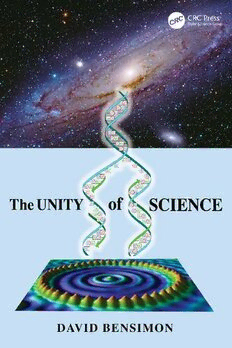
The Unity of Science PDF
Preview The Unity of Science
The Unity of Science The Unity of Science David Bensimon First edition published 2022 by CRC Press 6000 Broken Sound Parkway NW, Suite 300, Boca Raton, FL 33487-2742 and by CRC Press 2 Park Square, Milton Park, Abingdon, Oxon, OX14 4RN CRC Press is an imprint of Taylor & Francis Group, LLC © 2022 David Bensimon Reasonable efforts have been made to publish reliable data and information, but the author and pub- lisher cannot assume responsibility for the validity of all materials or the consequences of their use. The authors and publishers have attempted to trace the copyright holders of all material reproduced in this publication and apologize to copyright holders if permission to publish in this form has not been obtained. If any copyright material has not been acknowledged please write and let us know so we may rectify in any future reprint. Except as permitted under U.S. Copyright Law, no part of this book may be reprinted, reproduced, transmitted, or utilized in any form by any electronic, mechanical, or other means, now known or hereafter invented, including photocopying, microfilming, and recording, or in any information stor- age or retrieval system, without written permission from the publishers. For permission to photocopy or use material electronically from this work, access www.copyright. com or contact the Copyright Clearance Center, Inc. (CCC), 222 Rosewood Drive, Danvers, MA 01923, 978-750-8400. For works that are not available on CCC please contact mpkbookspermis- [email protected] Trademark notice: Product or corporate names may be trademarks or registered trademarks and are used only for identification and explanation without intent to infringe. Library of Congress Cataloging-in-Publication Data Names: Bensimon, David, author. Title: The unity of science / David Bensimon. Description: Boca Raton : Taylor and Francis, 2021. | Includes bibliographical references and index. Identifiers: LCCN 2021035071 (print) | LCCN 2021035072 (ebook) | ISBN 9781032112404 (hardback) | ISBN 9781032112411 (paperback) | ISBN 9781003218999 (ebook) Subjects: LCSH: Science--Philosophy. | Science. Classification: LCC Q175 .B458 2021 (print) | LCC Q175 (ebook) | DDC 501--dc23 LC record available at https://lccn.loc.gov/2021035071 LC ebook record available at https://lccn.loc.gov/2021035072 ISBN: 9781032112404 (hbk) ISBN: 9781032112411 (pbk) ISBN: 9781003218999 (ebk) DOI: 10.1201/9781003218999 Typeset in Nimbus font by KnowledgeWorks Global Ltd. Dedication Tothefutureenlightenmentofmygrand-children. Contents Preface.....................................................................................................................xiii Acknowledgements..................................................................................................xv Chapter1 TheUnityofScience......................................................................1 1.1 Introduction...........................................................................1 1.2 TheInventionofMathematics.............................................3 Chapter2 ClassicalMechanics.....................................................................11 2.1 (cid:95)Newton’sLawsofMotion...............................................11 2.2 (cid:95)Newton’sLawofGravitation.........................................16 2.2.1 GravitationalPotentialandEnergyConservation....18 Chapter3 Electromagnetism........................................................................21 3.1 (cid:95) Electrostatics..................................................................21 3.1.1 (cid:95) Coulomb’sLaw...................................................22 3.1.2 ApplicationsofCoulomb’sLaw..............................25 3.1.2.1 Lightning.................................................25 3.1.2.2 TheFieldofaDipole...............................26 3.1.2.3 Piezo-Electricity......................................28 3.1.3 (cid:95) Gauss’sTheorem.................................................29 3.1.4 ApplicationsofGauss’stheorem.............................31 3.1.4.1 TheCapacitor..........................................31 3.1.4.2 MeasuringtheChargeoftheElectron.....32 3.1.4.3 TheElectrostaticLens.............................33 3.1.5 SolvingPoisson’sEquation.....................................34 3.1.5.1 TheMethodofImages.............................35 3.1.6 ElectricFieldinMatter:Dielectrics.........................37 3.2 (cid:95)Magnetostatics.................................................................39 3.2.1 (cid:95) Volta’sBatteryandOhm’sLaw..........................39 3.2.2 (cid:95)Electrostatics,MagnetostaticsandRelativity: theLorentzForce.....................................................43 3.2.3 ApplicationsoftheLorentzForce...........................45 3.2.3.1 AuroraBorealis.......................................45 3.2.3.2 TheParticleAccelerator..........................47 3.2.3.3 ThePenningtrap......................................49 3.2.4 (cid:95) Ampe`re’sLaw.....................................................49 vii viii Contents 3.2.5 ApplicationsofAmpe`re’sLaw................................51 3.2.5.1 MagneticFieldofaCurrentSegment.....51 3.2.5.2 MagneticFieldofaCurrentLoop...........52 3.2.5.3 TheSolenoid............................................53 3.2.5.4 D’Arsonval’sGalvanometer....................55 3.2.6 Magnetic Fields in Matter: Permeability and PermanentMagnets..................................................55 3.3 (cid:95)ElectromagneticInduction.............................................57 3.3.1 (cid:95) Faraday’sLaw.....................................................57 3.3.2 ApplicationsofFaraday’sLaw................................60 3.3.2.1 Inductance................................................60 3.3.2.2 TheElectricTransformer.........................60 3.3.2.3 Electric Motor and Alternating Cur- rent(AC)Generator.................................61 3.3.2.4 ElectronicCircuits...................................62 3.4 (cid:95)Maxwell’sEquations.......................................................66 3.4.1 (cid:95) EnergyConservationandRadiatedPower..........70 3.4.2 ApplicationsofMaxwell’sEquations......................72 3.4.2.1 TheRadiatingDipole..............................72 3.4.2.2 TheDipoleAntenna................................73 3.4.2.3 TheParadoxofAtomicStability.............76 3.4.2.4 TheColoroftheSky...............................76 3.4.2.5 The Doppler-Fizeau Effect and the ExpansionoftheUniverse.......................78 3.4.2.6 TheDarknessofNight.............................79 3.5 Optics...................................................................................80 3.5.1 ElectromagneticWavesinMatter:Refraction.........81 3.5.2 Fermat’sPrinciple....................................................85 3.5.2.1 GeometricalOptics..................................86 3.5.3 Diffraction................................................................89 3.5.4 DispersionofLightandtheColorsoftheRainbow92 Chapter4 QuantumMechanics...................................................................97 4.1 (cid:95)ThePuzzlesofMatterandRadiation...........................98 4.1.1 (cid:95) Black-BodyRadiation.......................................100 4.1.1.1 TheSunandEarthTemperatures...........103 4.1.1.2 TheUniverseasaPerfectBlack-Body..104 4.1.2 ThePhoto-ElectricEffect.......................................106 4.1.2.1 DigitalCamerasandSolarCells............107 4.1.3 Bohr’sAtomandtheSpectrumofHydrogen........107 4.1.3.1 Particle-WaveDuality............................108 4.1.3.2 The Bohr-Sommerfeld Quantization Rule........................................................109 4.1.4 AbsorptionandStimulatedEmission....................109 Contents ix 4.2 (cid:95)QuantumMechanicalFormalism................................112 4.2.1 (cid:95) Example:ParticleinaBox................................118 4.3 SimpleQMsystems...........................................................120 4.3.1 TheChiralAmmoniaMolecule.............................120 4.3.1.1 Schro¨dinger’sCat..................................122 4.3.1.2 Bell’sInequalities..................................124 4.3.2 TheAmmoniaMoleculeinanElectricField.........124 4.3.2.1 TheAmmoniaMaser.............................125 4.3.3 TheEnergySpectrumofAromaticMolecules......128 4.3.4 ConductionBandsinSolids...................................129 4.4 (cid:95)Momentum,SpaceandEnergyOperators.................133 4.4.1 (cid:95) HeisenbergUncertaintyPrinciple.....................136 4.5 (cid:95)Schro¨dinger’sEquation................................................137 4.5.1 Particle-WaveDuality:Diffraction.........................137 4.5.2 ParticleInterferenceObservedwithBuckyballs....139 4.5.3 Particle-WaveDuality:Refraction.........................140 4.5.4 TheScanningTunnelingMicroscope....................142 4.5.5 (cid:95) TheCorrespondencePrinciple..........................144 4.6 (cid:95)Dirac’sEquation:AntiparticlesandSpin...................146 4.6.1 SpinandMagneticDipole.....................................149 4.6.2 Antiparticles...........................................................151 4.7 AngularMomentumWavefunction................................153 4.8 (cid:95)TheHydrogenAtomandElectronicOrbitals............155 4.9 (cid:95)ManyElectronSystems................................................157 4.9.1 (cid:95) ThePeriodicTableoftheElements..................158 4.10 TheChemicalBond..........................................................162 4.10.1 VariationalApproachtoMolecularEnergyLevels163 4.10.1.1 Hu¨ckel’sMolecularOrbitalTheory.......166 4.10.2 MolecularRotationalSpectrum.............................168 4.10.3 MolecularVibrationalSpectrum............................169 4.11 TimeIndependentPerturbationTheory........................172 4.11.1 EnergyLevelsinNon-HydrogenAtoms................174 4.11.2 TheStarkEffect.....................................................175 4.11.2.1 QuantumWells......................................175 4.11.2.2 DiatomicMolecules...............................176 4.11.3 TheZeemanEffect.................................................178 4.11.3.1 MagneticResonanceImaging(MRI)....180 4.12 TimeDependentPerturbationTheory...........................181 4.12.1 TransitionsbetweenElectronicEnergyLevels......183 4.12.2 MolecularRotational-VibrationalTransitions.......185 4.12.3 AbsorptionandFluorescenceEmission.................188 4.12.3.1 Super-ResolutionMicroscopy...............191 4.12.3.2 TheLaser...............................................193
